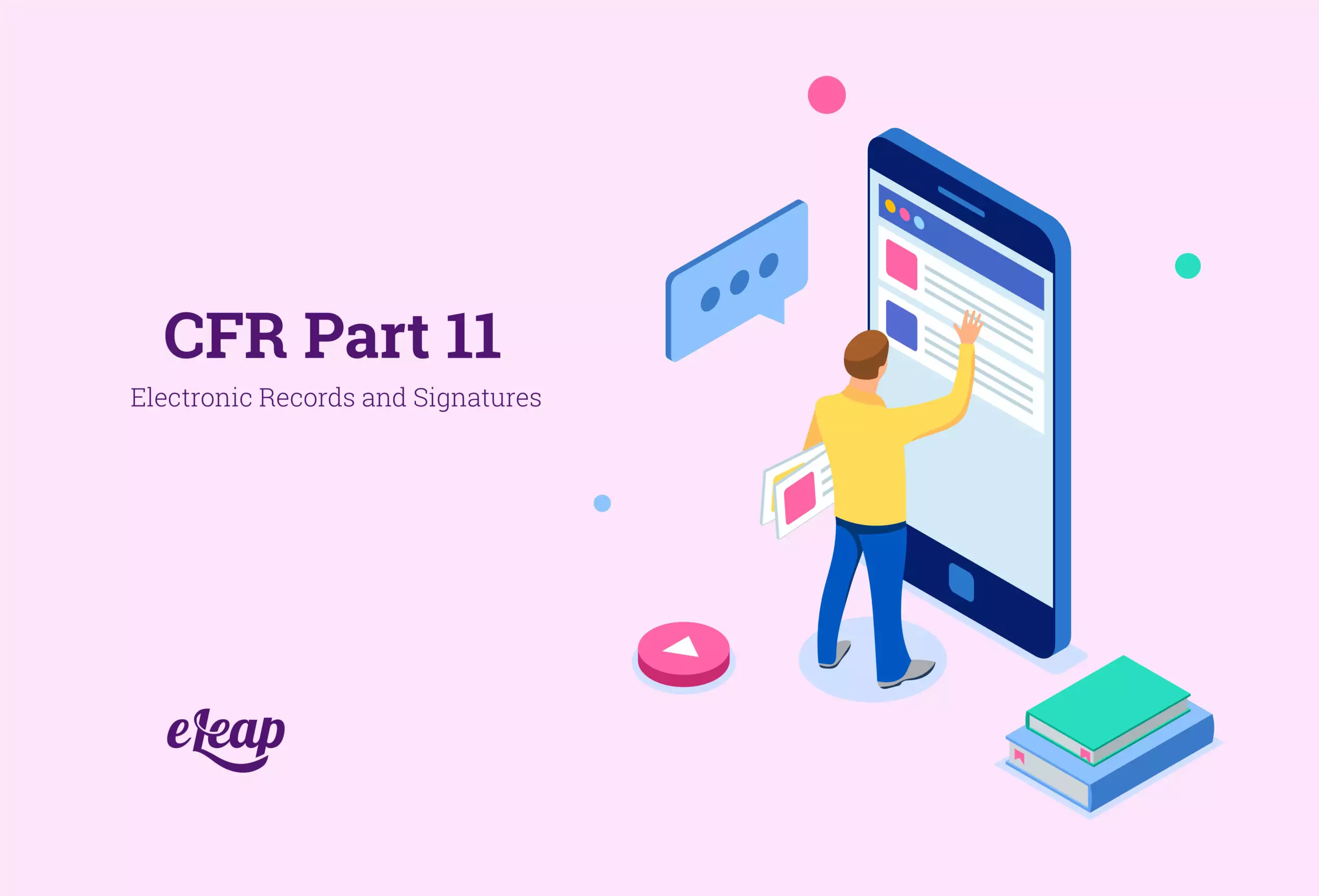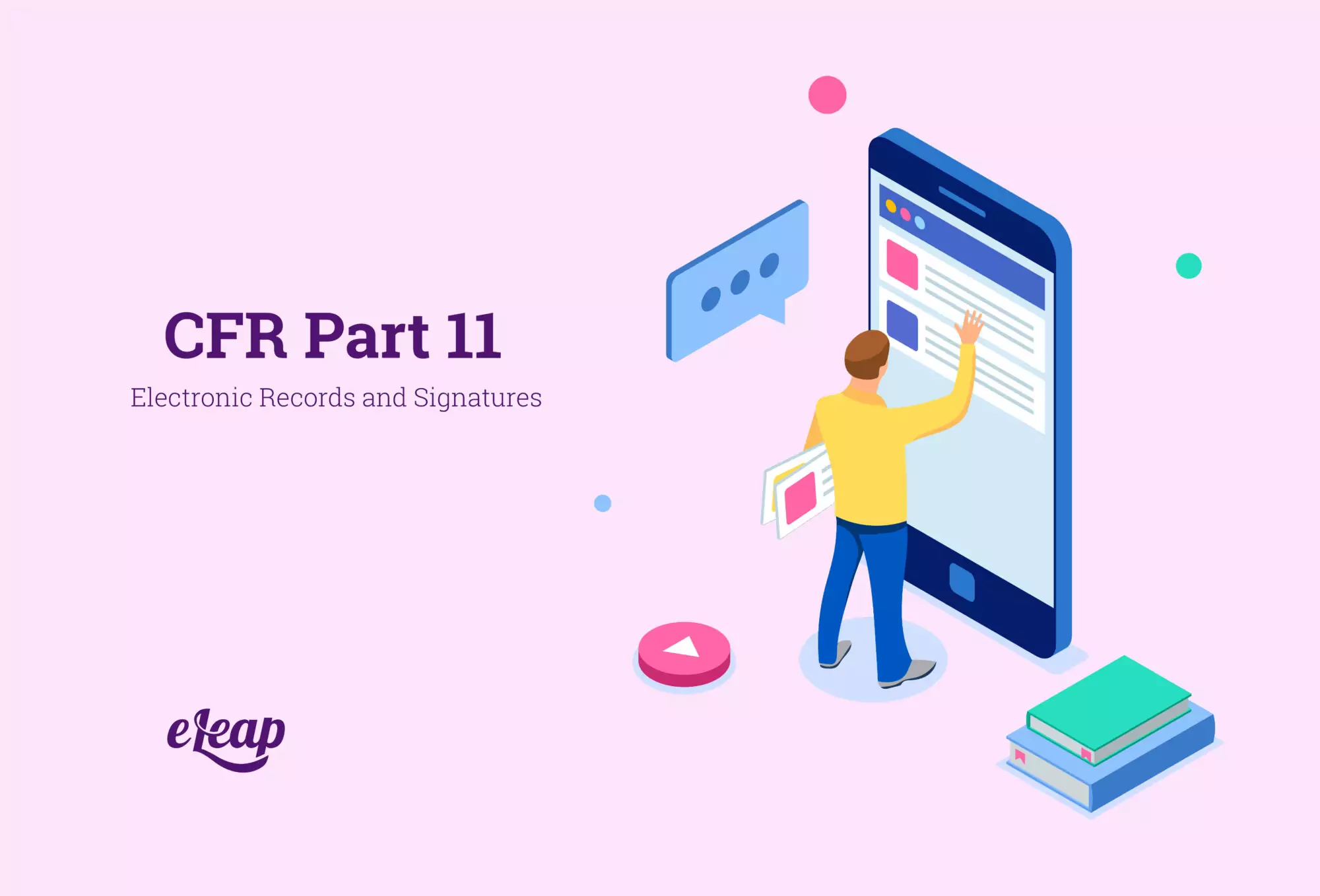CFR Part 11
Electronic Records and Signatures

These days, information security is paramount. Life sciences companies, especially, face challenges in complying with the CFR Part 11 rule of Title 21. This rule is what sets forth the compliance guidelines for information security and electronic systems, and it is one that everyone needs to be familiar with in order to take their business to the next level.
Understanding this code and what it means to your organization is perhaps the biggest part of the compliance puzzle. Below, you’ll find all the details about the goals, methods, systems, and other factors.
With the software market for life sciences expected to see growth to as much as $22.5 billion through 2024, now is the time to get started. Get started on the right foot with the eLeaP validated platform.

The Goals of CFR Part 11
Despite the fact that this guideline was created all the way back in 1997, it still holds applicable use in the modern digital age and was designed to cater to the ever-changing needs of this industry with assistance like:
- Training companies and individuals on how to use computer systems and software, as well as to troubleshoot them when they are not working effectively.
- Maintain secure, safe data that is protected from all threats and ensure that data does not get lost or corrupted.
- Ensure that signatures for review and approval are valid and legitimate and cannot be the subject of dispute.
- Tracing changes to data during its lifecycle to monitor security and potential risks along the way.
- Detecting and/or preventing falsified records or records breaches.
It’s also necessary for organizations to be more practical about how they manage paperwork across multiple offices or other multi-access needs. With today’s companies spread more globally and connected more remotely than ever before, paper-based systems just aren’t practical. Electronic records make far more sense and are far more efficient, but the challenge comes in proving to the regulating authorities that your system can handle the standards set forth by 21 CFR Part 11.
In doing that, and in learning more about this statute and how it may impact your organization, read on for five things you need to know about Part 11 and what it means to you. Also, feel free to connect with our CFR experts.
Digital Signatures and Electronic Signatures are Different
Title 21 CFR Part 11 is a very specific set of guidelines, and it explains carefully the difference between digital signatures, which aren’t monitored, and electronic signatures, which do fall under Part 11. Electronic signatures are those that are used to replace wet ink and are not validated with any kind of key or passcode or other digital authentication.
Digital signatures refer to those that are authenticated with another layer of security, such as a PIN number or password. These do not fall under Part 11 because of the two-factor authentication, but the electronic signature needs to meet all of the regulations of this compliance guideline.
Ask for Proof of Compliance Before Using Systems
In a perfect world, you would be able to take someone at their word when they tell you that they have the compliance tools that you need. When you’re looking at software that you can use for electronic signatures or records, you need to ask to see their proof of certification. Validating these systems is part of your due diligence in choosing the right solutions for managing and securing your data to meet Part 11 guidelines.
If you’re using SaaS (Software-as-a-Service) platforms, the vendor host and manager is going to hold more responsibility.
CFR Part 11 Compliance and FDA Compliance are the Same
If you’ve looked at software already, you may have noticed that some products are sold especially as CFR Part 11-compliant, but then there are others that are not marked as “FDA compliant” or otherwise validated. This is the same thing—whether it says “FDA” or “CFR,” the compliance is there. Of course, just because a provider claims that their software fits the bill doesn’t mean you should take their word for it. Ask to see their proof of validation so that you can guarantee their compliance before you choose their platforms.
It’s up to you to make sure that companies are compliant, as discussed above before you start working with them. By understanding the different terms and the way things are labeled, it will be easier for you to get what you need.
Not All Companies Have to Comply
While the majority of life sciences companies, including medical device and biotech brands, need to comply with Title 21 and the CFR Part 11 statute, not all companies will be subject to this regulatory compliance. In order to check to see whether you have to follow Title 21 CFR Part 11, you should consider whether you have any electronic records and take electronic signatures. If the answer is yes, the compliance is mandatory. Plus, you have to make sure that your hardware and software measure up, including if you’re using cloud-based or SaaS tools.
Electronic Signature Rules
In order to comply with 21 CFR Part 11, electronic signatures need to be captured in such a way that they are secure and password-protected whenever possible. Passwords need to be reviewed and approved regularly, and the guidelines of this statute even allow for a variety of electronic signature options:
- Handwriting capture
- Scanning
- Digital signatures (with PIN codes or keys)
- Biometrics, such as fingerprints or facial recognition
Any and all of these secure methods can be used to allow both employees and clients alike to trust that they are being given a compliant process to deliver secure electronic records, no matter what area of life sciences they work in. The entire premise of this guideline is to establish security for electronic signatures, after all, so having the right tools is critical to your success.
It’s about regulatory compliance, but it’s also about protecting your organization. With CFR Part 11, the knowledge is half the battle, and once you know what’s expected, you can deliver the best electronic security compliance every single time. eLeaP is a validated software platform to meet CFR Part 11 compliance.